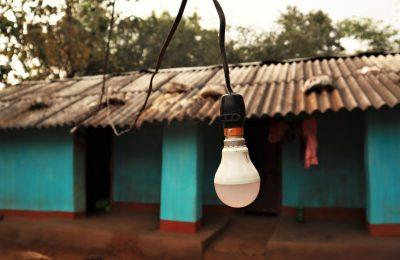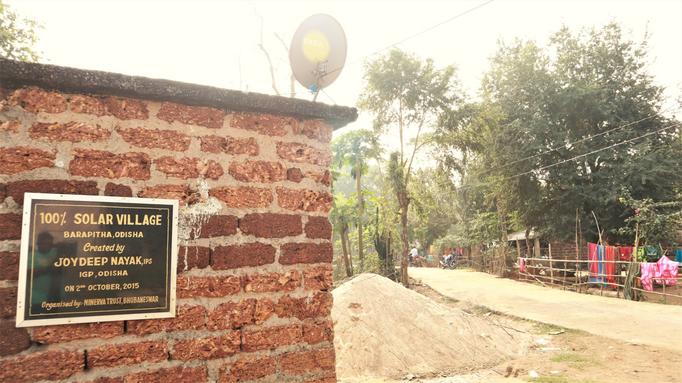Electricity is still a distant dream in parts of India, but solar energy has been able to end the darkness that prevailed over the past decades in several villages, and changed the lives of many.
Before 2015, the Indian village of Parapitha lived in complete darkness like the rest of the neighboring villages without electricity, and this year was a unique achievement for its residents, as their first village in the state of Odisha became dependent on solar energy.
The government company "Nalco" of the Ministry of Mines, private solar energy companies and battery developers cooperated to implement the project.
However, the happiness of 60 families did not last long, and the village began to depend on electricity connected to the network, and several factors contributed to this, including poor maintenance and lack of monitoring operations.
How did you change the life of an entire village?
The village of Parapitha is located near the Chandaka Wildlife Sanctuary, 1 km from the famous Deras Dam.
Before 2015, most families used to go to bed by 5 pm; Fear of meeting wild animals, such as elephants and snakes, in the dark.
On October 2, 2015, the village's fate completely changed, and it celebrated the title of "the first village to rely on 100% solar energy in the state of Odisha" in the presence of local officials, politicians and residents of the village and surrounding areas, according to Money Control.
The clean energy project provided the village with electricity, and its residents were able to light the streets with lamps, and leave their homes even at night, in addition to the spread of mobile phones and electrical appliances in homes.
In addition, children were able to study at night, and villagers felt safe and able to protect themselves from animals and criminal activities.
According to Nalco's website, each family received two solar-powered lamps and a mobile charging point, while solar-powered lamps lit up the village road.
The company added that it had installed mast lights at the village's primary school and childcare centre.
Village resident Bipin Kumar Singh said: “Cell phones and electrical appliances were difficult to use, and a few families relied on charging their phones in the markets of Bhubaneswar for some fees, and some families with TVs and rechargeable lamps used to use batteries in their homes, but Most of the citizens at that time relied on using oil lamps at night.
The solar energy is also credited with helping the women of the village to go out at night, and finish a lot of housework in the evening, and it became easy for girls to go to school and return to school after the dark roads hindered their education.
In contrast to decentralized solar technologies, the village was given a unique disaster-resistant and foldable model, whereby the solar panels could be easily folded by anyone during difficult weather conditions, such as hurricanes.
The local meeting room was provided with a TV and antenna so that citizens could watch the weather news and take the necessary measures.
As of December 2021, Odisha had the highest installed capacity of renewable energy in eastern India at 597 MW, according to the latest data from the Central Electricity Authority.


But what happened?
After 3 years of installation, the project collapsed and has been without maintenance ever since.
The villagers claimed that Hurricane Fani in 2017, contributed to the breakdown of the system and the failure of the batteries, and they were unable to repair it, explaining that some technicians checked the system and discovered malfunctions in the inverter and batteries.
After they had a special foldable system to ensure their safety during hurricanes, and a lightning rod system near the solar mini-grid, the residents abandoned it, using grid-connected electricity after it had entered the village by then.
The villagers believe that the lack of maintenance and training was the reason behind the failure of the project.
According to technical experts in the sector, maintenance is the backbone of any solar energy project, and a lack of that can reduce its efficiency and lifespan.
White Sharks co-founder Charthak Shankar Bhagat said that most of the components of the solar power plants have a warranty, as the batteries and inverters have a 5-year warranty, while the warranty of the solar panels lasts for 25 years.
He continued, "However, there is a need to provide regular maintenance, such as cleaning the panels, checking battery fluid levels, etc., to ensure the quality and life of these stations."
He added, "Lack of maintenance can reduce the plant's work efficiency by 60% within a few days."
Bhagat cited many solar street lights in many rural areas, and how they failed due to lack of maintenance and reporting.
"Many solar projects have failed in several parts of the country due to the lack of a central monitoring system that ensures that the authorities maintain and repair the system in a timely manner and prevent it from stopping," he said.
He explained that these projects require precise skills that are not available to local technicians who lack experience, stressing the need to document maintenance work and allocate a budget for it when starting these projects.
The reason for failure in Indian villages
Although India attaches great importance to solar energy projects, in addition to providing decentralized solutions to transfer electricity to remote areas, poor maintenance and lack of follow-up still hinder its spread.
Parapitha is not the only village in India that has demonstrated the failure of decentralized solar energy systems, Bihar - too - has suffered a similar tragedy.
Having been awarded the title of Dharnai's first solar-powered village, the failure to replace faulty batteries led to a complete failure of the system after 3 years of operation.
In July 2014, solar energy ended the darkness that had prevailed in the village for the past three decades.
The project succeeded during the first years, but after two years things took another turn after the battery life expired, and the failure to replace it contributed to the stopping of the solar power plant.
According to the villagers, many villagers used solar energy, despite its high cost - 9 rupees ($0.12) per unit - to promote renewable energy. About 400 homes were involved in the project, but the number later decreased.
In theory, more than 100 homes are still connected to solar energy, but the truth is that the power plant is shut down, and it doesn't power a single home.
What is shocking about this village's experience is that the buildings adjacent to the solar power plant have been used by local residents as animal shelters after government officials have long stopped visiting them.
Read also..
Follow the latest energy news via Google NewSubscribe to the newsletter to receive the most important energy news.TagsSolar energy Solar energy in India Renewable energy in India India